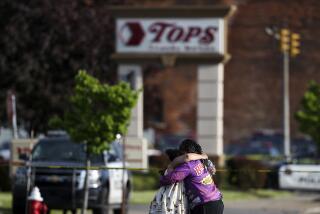Washington’s Hogs Play, Buffalo’s Get Eaten : Culture: There are similarities in the cities, but none involve pretense or expectations.
- Share via
WASHINGTON — When in Rome, as the saying goes, do as the Romans do. Maxims may be easy to remember, but they are hard to live by, especially this one.
I’m from Buffalo, a city often confused in the American mind with Reykjavik, but have lived here for the last five years, witnessing all kinds of curious things, including Redskin fans.
Naturally, I don’t hoot and holler for “the Hogs,” as the Redskins are known here. Even if I wanted to, which I don’t, I couldn’t; ties to Buffalo are too strong. Neither is it possible, though, to hoot and holler for the Bills in the nation’s capital. Being a Bill fan in Washington is a lot like being Custer at the Little Big Horn. I’m overwhelmed by the numbers of fans and their zest for the kill.
“Give us Buffalo!” supporters in Georgetown chanted before TV cameras earlier this month when the Redskins easily handled the Detroit Lions. They look to the matchup between the Bills and the Redskins much the way they saw the U.S. war effort in the Persian Gulf last year. They expect a rout.
Sunday’s Super Bowl has complicated my existence. It has reminded me how little Buffalo and Washington have in common, other than that in both cities the interstate signs are green. The game is not only a showdown between the AFC and the NFC, but also something sportswriters seldom mention: It is a symbolic confrontation between two very different cultures.
Buffalo and Washington do have certain things in common. As planned by Joseph Ellicott, Buffalo was designed around a grid system of streets radiating out from public squares. This resemblance to Washington was no accident. Ellicott’s brother worked with Pierre L’Enfant as an architect in the planning of the nation’s capital.
Also like Washington, Buffalo was burned to the ground when the British invaded the United States in 1812. In the first of many desertions that have plagued the city throughout its history, both the villagers and the U.S. Army stationed along the Niagara frontier abandoned the town to the British, who promptly torched the wood-frame homes.
But all of that was long ago. I can’t think of an American city more unlike Washington today than Buffalo, a town that has been so shunned by history that chicken wings and blizzards are the only surviving tokens of its culture.
Buffalo has taken its share of knocks. As its local historians like to point out, Buffalo used to be one of the nation’s commercial giants. Even before heavy industry arrived in the Queen City, as it was called in the 19th Century, more trade moved through its harbor than through any other city in America.
Buffalo spent the previous century on a roll as an American boom town, but look where that’s gotten it. There are as many abandoned factories in Western New York as there are congressional tombstones in the District of Columbia. Although no town’s prospects seemed as bright as Buffalo’s at the turn of the century, the future, as is true for many cities in the industrial Northeast, has been a tale of disappointment. Buffalonians have learned the hard way that today’s boom is often tomorrow’s bane.
Humbled by history, Buffalonians are known for their generous nature and down-to-earth pleasures. If Washington is a place you go when you want to enhance your resume, Buffalo is a town you visit when you want to exchange the symbolic equivalent of a hug.
Just look at Buffalo’s economy. Things like grain, pork, whiskey, lead, beeswax, potatoes, iron, beans, cranberries and immigrants have traditionally passed through the Queen City.
What moves through Washington may not be quite as tangible. Washington is a city where dapper dignitaries, widely known media personalities, eminent attorneys and prosperous lobbyists thrive by nurturing contacts with their own kind. Ultra-stretch limos cruise up and down the main avenues with tiny exotic flags waving from each fender.
Washington is a city of Ivy Leaguers hungry for achievement, or at least recognition. In the nation’s capital, the car of choice is a Mercedes 300. If you haven’t achieved fame yet, then a BMW 525 will have to do.
In Buffalo, the label on the sausage you eat is more important than the make of your car.
Other differences come easily to mind. Washingtonians ride their subway trains in silence, network exhaustively, like to be seen at the Kennedy Center, drink dry white wines, drop names and rarely laugh.
Buffalonians dress like frumpy Eastern Europeans, talk back to their TVs and radios, love gaudy Christmas tree ornaments, eat so well and bellow so loudly when amused that they are an embarrassment in public.
And whereas Washington is noted for its many elegant restaurants, Buffalo is famous for its galactic-size grocery stores, like Tops and Wegman’s, where you could lose your way, if not your soul, beneath mountains of colorful produce, fresh fish, beef and baked goods.
Washington is internationally known and admired for its lush parks, public monuments and defense contractors. Buffalo is so unrenowned that the Kremlin overlooked it when targeting American cities for nuclear destruction.
It’s not customary to view a football game as a conflict between cultures, but that’s what Super Bowl XXVI is. Washington and Buffalo stand for different ways of facing reality, perhaps for living in the ‘90s.
While many people were enjoying the high-rolling ‘80s, Buffalo was struggling to reconcile itself to diminishing expectations. Ironically, Buffalo now seems to be in the avant-garde, having gone through what the rest of America is only now beginning to experience. Buffalonians have endured the history that Washingtonians imagine they make.
A popular T-shirt in Buffalo perhaps sums it best: “Buffalo, City of No Illusions.”
More to Read
Go beyond the scoreboard
Get the latest on L.A.'s teams in the daily Sports Report newsletter.
You may occasionally receive promotional content from the Los Angeles Times.










